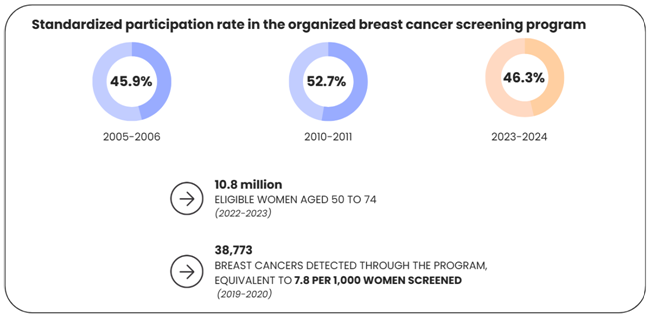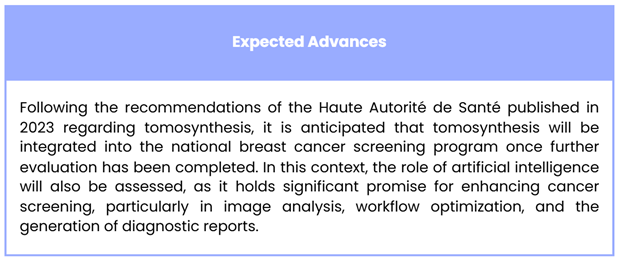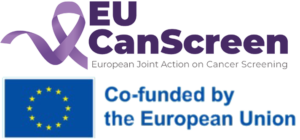Organized Breast Cancer Screening Program in France
Participation Trends and Perspectives

Organized Breast Cancer Screening Program in France
Organized breast cancer screening was rolled out in France in 2004.
Aimed at detecting the most common and deadliest cancer among women, the program has experienced a gradual decline in participation rates over the past decade, across all age groups and regions. However, it is worth noting that around 11% of the target population opts for individual screening outside the organized program.
After reaching a peak participation rate of 52.7% during the 2010-2011 period, the rate has since declined by more than 12 percentage points, falling to 46.3% for the 2023-2024 period.

Screening Modalities
The organized breast cancer screening program targets women aged 50 to 74 at average risk. These women receive an invitation every two years to undergo a mammogram and a clinical breast examination, performed by an accredited radiologist.
The program is governed by comprehensive guidelines detailing its procedures, monitoring, and evaluation:
- – Every two years, eligible women receive a personalized invitation via mail, email, or SMS to consult an accredited radiologist.
- – The screening includes a mammogram (two images per breast: frontal and oblique views) combined with a clinical breast examination. The procedure is fully covered by national health insurance (Assurance Maladie), with no upfront costs for the patient.
- – Mammograms are systematically reviewed by a second expert radiologist if no abnormality is detected by the first reader. First readers must interpret at least 500 mammograms per year, while second readers must review at least 1,500 annually.
- – In case of a suspected abnormality, the first radiologist immediately conducts further diagnostic assessments, enabling quicker treatment decisions and reducing patient anxiety.
Outreach initiatives, known as “aller vers” actions, are currently being tested and implemented. These initiatives target vulnerable, underserved, and socially disadvantaged populations who are often distant from healthcare systems.

#EuCanScreen #CancerScreening #HealthCare #CancerPrevention #LungCancer #BreastCancer
Subscribe to our newsletter to get news and updates.
Subscribe to our newsletter to get news and updates.

The general objective of EUCanScreen is to assure sustainable implementation of high-quality screening for breast, cervical and colorectal cancers, as well as implementation of the recently recommended screening programs – for lung, prostate and gastric cancers. EUCanScreen will facilitate the reduction of cancer burden and achieving equity across the EU.
This project has received funding from the European Union’s EU4HEALTH Programme under the Grant Agreement no 101162959










